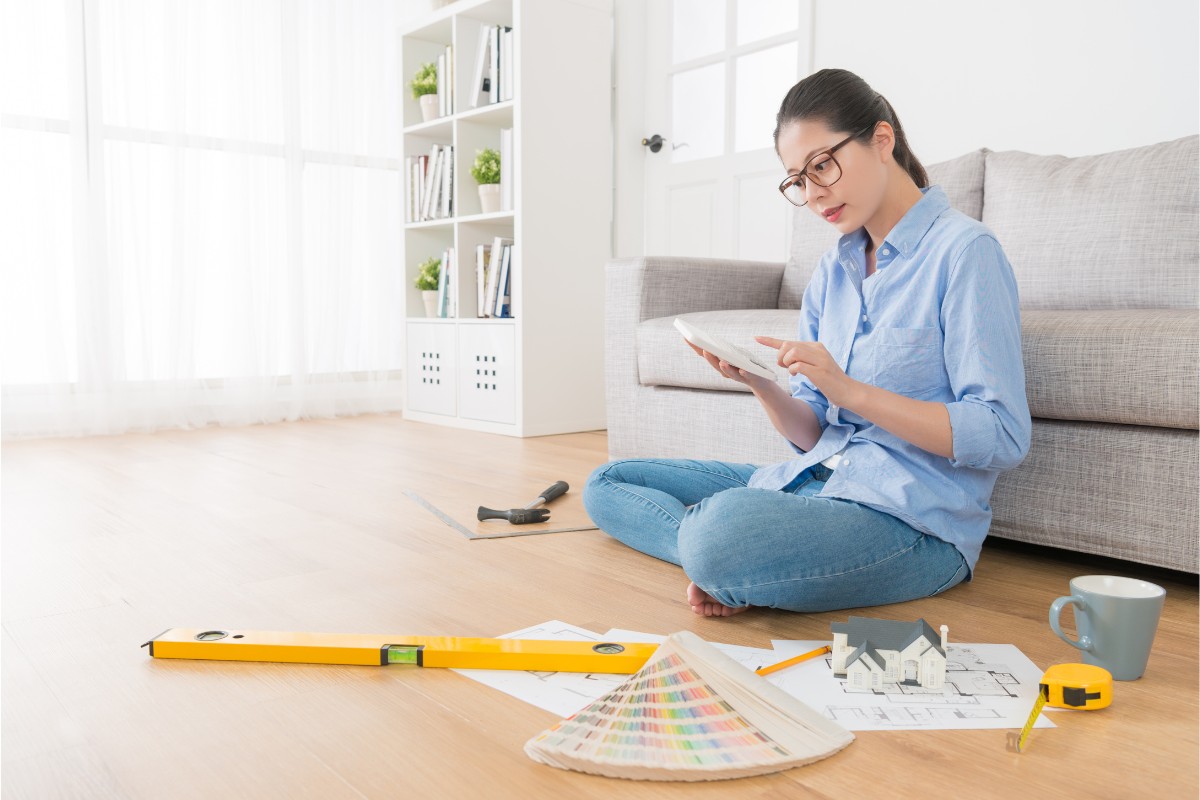So, you’ve decided to pursue a career in interior design.
Well done choosing a path that allows you to blend creativity, style, and functionality while being paid well.
In this article, we will provide a detailed guide on how to become an interior designer.
Whether you’re a budding artist or someone looking for a career change, this guide is tailored to help you achieve your dreams.
Post Contents
- 1 What Is The Role Of An Interior Designer?
- 2 How To Become An Interior Designer
- 3 Skills You Need to Become an Interior Designer
- 4 Frequently Asked Questions
- 5 Conclusion
What Is The Role Of An Interior Designer?

An interior designer is tasked with curating and enhancing the interiors of buildings to make them both functional and visually appealing to their clients.
Their responsibilities encompass suggesting wall colors, lighting arrangements, fixtures, furniture, and fabrics to improve a space.
Additionally, they may oversee structural design elements within a room, including built-in shelving, stairs, ceiling designs, and more.
The responsibilities of an interior designer include the following:
- Meeting with clients to comprehend their requirements and budget.
- Surveying, measuring, and analyzing how the project space will be utilized.
- Collaborating with installers, electricians, painters, decorators, architects, and other construction professionals to execute a project.
- Evaluating color palettes, materials, fabrics, fixtures, decorations, furniture, and the overall environment.
- Creating sketches and mood boards for client approval.
- Preparing detailed drawings and designs tailored to meet the client’s needs, often utilizing computer software.
- Sourcing suppliers for fixtures, furniture, interior decorations, and materials.
How To Become An Interior Designer
1. The Foundation Can be an Education

Your journey begins with a solid educational foundation.
To embark on this path, you need to research accredited interior design programs.
Look for institutions that offer programs aligned with your career goals and aspirations.
Once you’ve identified suitable programs, enroll in one that aligns with your career goals.
These programs provide a structured curriculum that imparts essential knowledge and skills.
In your academic journey, pay special attention to coursework that covers design principles, color theory, and space planning.
These fundamental concepts are the building blocks of any successful interior designer’s career.
2. Developing Technical Skills
Interior designers rely on various software programs, such as AutoCAD and 3D modeling tools, to create precise design plans and visualize their concepts.
Learning to use these tools effectively is crucial for translating your creative ideas into practical, real-world designs.
By honing your technical skills and mastering these software applications, you enhance your capacity to craft intricate and visually appealing interiors and ensure that your designs meet your client’s functional and aesthetic requirements.
In today’s digital age, integrating software into the creative design process is essential to an interior designer’s skill set.
3. Gain Practical Experience
Practical experience is a crucial stepping stone to success in almost every field, and here, it is not an exception.
Seek internships with well-established design firms, as they offer invaluable real-world exposure to the industry.
Collaborating with experienced designers on real projects is a good idea, as it allows you to learn by doing.
You’ll gain insights into client interactions, project management, and the day-to-day challenges of an interior designer.
Apply the knowledge gained from your coursework to real-world design scenarios.
This is where you hone your problem-solving skills and begin to develop your unique design style.
4. Build Your Portfolio
Document Your Best Projects
Your portfolio is your professional identity.
Document your best projects with high-quality photos.
These visuals should showcase your design skills, attention to detail, and ability to create visually stunning spaces.
Highlight Your Design Process
In your portfolio, provide insights into your design process.
Explain how you approach a project, your problem-solving methods, and the rationale behind your design choices because it helps potential clients understand your creative process.
Showcase a Variety of Design Styles and Challenges
A diverse portfolio showcasing various design styles and the challenges you’ve overcome demonstrates your versatility as a designer.
Clients want to know that you can adapt to design needs and deliver exceptional results.
5. Networking

Attend Industry Events and Trade Shows
Interior design is a people-oriented profession.
Attend industry events and trade shows to connect with like-minded individuals, potential clients, and industry professionals.
These events provide a platform to learn about the latest trends and products.
Join Professional Associations
Consider joining professional associations like the International Interior Design Association or ASID – American Society of Interior Designers.
These organizations offer networking opportunities, resources, and the chance to stay updated with industry developments.
Collaborate with Other Designers and Professionals
Collaboration is often the key to success in interior design.
Work with other designers, architects, and industry professionals on projects.
It not only expands your knowledge but also broadens your professional network.
6. Market Yourself
A robust online presence is crucial for success in today’s digital age.
Establish a website and use social media platforms to showcase your work.
This is where potential clients can discover your portfolio, and it’s a powerful marketing tool.
Good marketing and customer service skills are essential for success in this field.
Your ability to communicate your ideas effectively and provide excellent client service will set you apart from the competition.
7. Stay Current
Interior design is an ever-evolving field, and to remain at the top of your game:
- Continue your education by taking relevant courses.
- Stay informed by reading design publications and blogs.
- Experiment with new design software and tools to enhance your skills.
Skills You Need to Become an Interior Designer

Becoming a successful interior designer requires a unique set of skills that go beyond a keen eye for aesthetics.
Creativity
At the heart of interior design lies originality.
You must be able to envision and conceptualize innovative design ideas that breathe life into spaces.
Your creative flair will set you apart and enable you to craft unique and captivating interiors.
Attention to Detail
The ability to focus on the finer details, from color schemes and furniture placement to materials and lighting, is crucial.
These details collectively define the quality of your work.
Spatial Awareness
Understanding spatial relationships is fundamental.
Interior designers must accurately assess how different elements fit together within a space.
This skill helps you optimize the functionality and flow of a room.
Communication Skills
Interior designers often work closely with clients, contractors, and other professionals.
Effective communication is essential for understanding clients’ needs, articulating your ideas, and collaborating seamlessly with others involved in the project.
Problem-Solving
Interior design projects can present unexpected challenges.
Your problem-solving skills will be put to the test as you find creative solutions to design dilemmas, such as working within a budget or addressing structural constraints.
Time Management
Effective time management ensures projects progress smoothly and clients are satisfied.
You’ll need to juggle multiple tasks and priorities efficiently to not miss any deadlines.
Technical Proficiency
Mastering design software and tools is a must, as we discussed.
Proficiency in programs like AutoCAD, SketchUp, and Adobe Creative Suite allows you to create accurate design plans, 3D models, and visual representations of your ideas.
Knowledge of Building Codes and Regulations
Interior designers must be well-versed in local building codes and regulations to ensure safety and compliance.
This knowledge guides your design decisions, especially regarding structural modifications.
Flexibility
Design trends change, and client preferences vary.
Being adaptable and open to new ideas is essential for staying relevant and meeting the diverse needs of your clientele.
Frequently Asked Questions
Is a degree in interior design necessary?
While not strictly mandatory, having a degree in interior design significantly boosts your career prospects and provides you with a solid knowledge base.
It not only enhances your understanding of design principles but also provides access to a network of industry professionals and the credibility clients often seek.
What software do interior designers use?
Interior designers frequently utilize software tools such as AutoCAD, SketchUp, and Adobe Creative Suite.
These applications are indispensable for creating precise design plans, 3D models, and visually stunning renderings.
Familiarity with these software programs is crucial for streamlining the design process and bringing creative visions to life.
What are the earning prospects for interior designers?
Earnings in the field of interior design can vary significantly based on factors such as location and experience.
Entry-level designers might earn around $45,000 per year, while seasoned professionals can command salaries of $100,000 or more annually.
Additionally, the variety and scale of projects you take on can impact your income.
Do interior designers work independently or for firms?
Interior designers have diverse career options, as they can work independently, offering their services directly to clients.
Alternatively, many interior designers find employment in established design firms collaborating with a team of professionals.
Some also opt for collaboration with architects on large-scale projects, showcasing the versatility of the profession.
Conclusion
Becoming an interior designer is a rewarding journey filled with creativity, innovation, and the opportunity to transform spaces.
This guide helped you learn how to become an interior designer and know you have a strong foundation for your interior design career.
Remember, the key to success is a passion for design, continuous learning, and building a solid portfolio.
So, embrace your creativity, and let your journey as an interior designer begin!






























